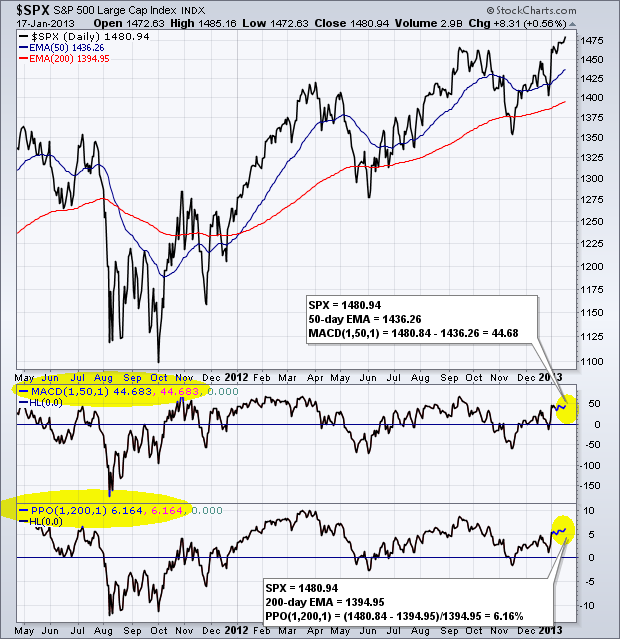|
|
Chartists can use MACD and the Percent Price Oscillator (PPO) to measure the difference between price and an exponential moving average. MACD is the absolute difference between two exponential moving averages. The PPO is the percentage difference between two exponential moving averages. The chart below shows the S&P 500 with the 50-day EMA and 200-day EMA in the main window. MACD (1,50,1) is shown in the first indicator window, while PPO(1,200,1) is shown in the second indicator window. Setting the parameter to a value of 1 means this is a 1-day EMA, which equals the closing price. The third parameter, which is also 1, is for the signal line, which is not needed in this example. MACD(1,50,1) is just the closing price less the 50-day day EMA. MACD is positive when prices are above the 50-day EMA and negative when below.

The PPO takes MACD one step further by dividing the difference by the longer exponential moving average. The first step for PPO(1,200,1) is to subtract the 200-day EMA from the 1-day EMA (closing price). This difference is then divided by the 200-day EMA, which shows the difference as a percentage of the 200-day EMA. This value tells us how far the close is from the 200-day EMA (in percentage terms). $SPX is currently over 6% above its 200-day EMA. Chartists can use these values to identify overbought and oversold conditions. You can read more on MACD and the Percent Price Oscillator (PPO) in our ChartSchool.

The PPO takes MACD one step further by dividing the difference by the longer exponential moving average. The first step for PPO(1,200,1) is to subtract the 200-day EMA from the 1-day EMA (closing price). This difference is then divided by the 200-day EMA, which shows the difference as a percentage of the 200-day EMA. This value tells us how far the close is from the 200-day EMA (in percentage terms). $SPX is currently over 6% above its 200-day EMA. Chartists can use these values to identify overbought and oversold conditions. You can read more on MACD and the Percent Price Oscillator (PPO) in our ChartSchool.


